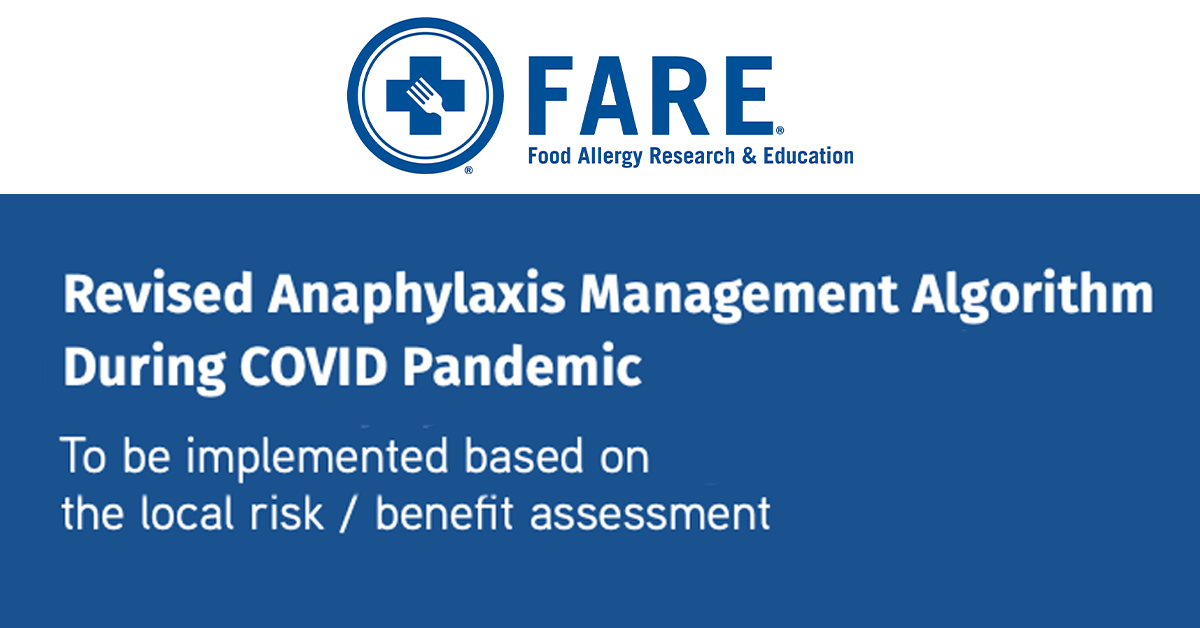New Recommendations Come as Patients Suffering Severe Allergic Reactions Fear Visiting Emergency Departments
McLEAN, Va. (April 21, 2020) — Dr. Thomas B. Casale, chief medical advisor for operations with FARE (Food Allergy Research & Education) and professor of medicine and pediatrics at the University of South Florida, published a paper in The Journal of Allergy and Clinical Immunology: In Practice, “Acute At Home Management Of Anaphylaxis During The COVID-19 Pandemic.” In the paper, Dr. Casale outlines why the traditional recommendations for emergency care related to anaphylaxis must change during the COVID-19 pandemic.
In recent years, medical claims with diagnoses of anaphylactic food reactions have increased nearly 400 percent in the United States. In ordinary times, a food allergy reaction sends one person in the U.S. to the emergency room every three minutes. But these are not ordinary times. Dr. Casale and his co-authors suggest that, given the significant risk of contracting COVID-19 while seeking emergency care for anaphylaxis, in-home treatment may be the safer course of action for many food allergy patients.
“Emergency departments are overwhelmed by the COVID-19 crisis and an anaphylactic event is very serious, but at-home care is possible in many situations so long as extra precautions are taken on behalf of both patients and caregivers,” said Dr. Casale. “It is our hope that in pivoting where possible we can protect food allergy patients nationwide while simultaneously slowing the spread of this virus.”
The revised anaphylaxis management algorithm outlined in the new paper suggests patients experiencing anaphylaxis follow these steps:
- Inject epinephrine immediately
- Ask for help from a housemate or neighbor, and lay down with legs elevated near an unlocked doorway
- Administer oral antihistamine, administer albuterol for respiratory symptoms if prescribed and available, and monitor symptoms.
- If symptoms do improve, closely monitor for 4-6 hours and notify a physician on a non-urgent basis.
- If symptoms do not improve or they worsen, administer epinephrine once more. If still no improvement, activate emergency services.
“Food allergies affect more than 32 million Americans, some of which are life-threatening and can result in anaphylaxis and death,” said Lisa Gable, chief executive officer of FARE. “It is important our community does all they can to limit risk of exposure to the coronavirus. Our team of medical experts is closely monitoring the pandemic and will revise anaphylaxis management recommendations as necessary, always keeping the health and safety of patients a top priority.”
Dr. Casale’s advice is targeted at medical professionals. It is critical that food allergy patients and families consult their physicians before making changes to their personal care plan.

Click here for a PDF version of this algorithm.
Media Contact:
media@foodallergy.org
For general inquiries, please call 800-929-4040.
About FARE
FARE (Food Allergy Research & Education) is the world’s leading food allergy advocacy organization and the largest private funder of food allergy research. Our mission is to improve the quality of life and the health of individuals with food allergies, and to provide them hope through the promise of new treatments. FARE is transforming the future of food allergy through innovative initiatives that will lead to increased awareness, new and improved treatments and prevention strategies, effective policies and legislation and novel approaches to managing the disease. For more information, please visit www.foodallergy.org. To join FARE’s transformative five-year fundraising and awareness campaign, Contains: Courage®, supporting families living with food allergies and educating ALL communities about the disease, visit www.foodallergy.org/containscourage.
Discounts and Guidance on Ordering Allergy-Friendly Foods Online: #SnackSafelyAtHome





